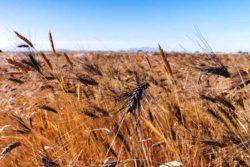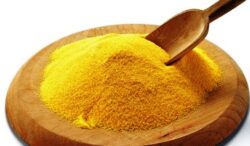Read Time: 5 Minutes Subscribe & Share
Flour And Flavor
On my first trip to Sicily several years ago, we stayed in what I called the Anti-Disney village of Scopello. It was there that I first tasted actual flavor in the flour used for local Sicilian white br eads. Whole grain breads don’t count, of course—you expect to taste the bran and other virtuous components your conscience says you need. But white bread? That was a revelation. No wonder Sicily was called the granary of the Roman Empire. My curiosity led me to investigate the differences between American, European, and Canadian flours. I often found the terminology confusing, even when searching for organic options. And as it turns out, North American flours have some intriguing distinctions from those in the European Union.
eads. Whole grain breads don’t count, of course—you expect to taste the bran and other virtuous components your conscience says you need. But white bread? That was a revelation. No wonder Sicily was called the granary of the Roman Empire. My curiosity led me to investigate the differences between American, European, and Canadian flours. I often found the terminology confusing, even when searching for organic options. And as it turns out, North American flours have some intriguing distinctions from those in the European Union.
Wheat 101
In North America, six classes of wheat are commercially grown: durum wheat, hard red spring wheat, hard red winter wheat, soft red winter wheat, hard white wheat, and soft white wheat. The majority of flour-producing wheat in the U.S. and Canada comes from the hard red varieties or durum wheat, both of which are high in protein and, therefore, packed with more gluten strands than their softer counterparts. This higher gluten content can make nutrients harder to absorb for those with digestive issues. Gluten intolerance—sometimes dismissed as a foodie fad—has become a very real malady, varying in severity. Meanwhile, European countries grow significantly more soft wheat varieties. Adding to the mix, American wheat crops often suffer from sulfur deficiency in the soil, which increases gliadin levels—a protein in gluten that tends to be more allergenic. Since gliadin levels are lower in soft wheat, this might explain why some gluten-sensitive travelers happily tuck into pasta and pizza in Italy with no ill effects.
hard red winter wheat, soft red winter wheat, hard white wheat, and soft white wheat. The majority of flour-producing wheat in the U.S. and Canada comes from the hard red varieties or durum wheat, both of which are high in protein and, therefore, packed with more gluten strands than their softer counterparts. This higher gluten content can make nutrients harder to absorb for those with digestive issues. Gluten intolerance—sometimes dismissed as a foodie fad—has become a very real malady, varying in severity. Meanwhile, European countries grow significantly more soft wheat varieties. Adding to the mix, American wheat crops often suffer from sulfur deficiency in the soil, which increases gliadin levels—a protein in gluten that tends to be more allergenic. Since gliadin levels are lower in soft wheat, this might explain why some gluten-sensitive travelers happily tuck into pasta and pizza in Italy with no ill effects.
 If your eyes glaze over when reading flour labels, here are some useful facts about the differences between American and European flours, particularly those in Italy. When you see the term “Grano Tenero,” it refers to soft wheat, while “Grano Duro” corresponds to what we would call hard wheat. And it is the Durum wheat that produces “semolina” or “semola”. These terms along with “durum semolina.” are interchangeable. Whole meal semolina has the bran intact, whereas if the bran is removed, you get a bright yellow milled grain. Because durum wheat is so hard, it is sometimes milled again, resulting in “Semola Rimacinata” (twice-milled semolina). Less common is “Semolato,” an ultra-finely ground semolina flour often used as a base for certain pastas.
If your eyes glaze over when reading flour labels, here are some useful facts about the differences between American and European flours, particularly those in Italy. When you see the term “Grano Tenero,” it refers to soft wheat, while “Grano Duro” corresponds to what we would call hard wheat. And it is the Durum wheat that produces “semolina” or “semola”. These terms along with “durum semolina.” are interchangeable. Whole meal semolina has the bran intact, whereas if the bran is removed, you get a bright yellow milled grain. Because durum wheat is so hard, it is sometimes milled again, resulting in “Semola Rimacinata” (twice-milled semolina). Less common is “Semolato,” an ultra-finely ground semolina flour often used as a base for certain pastas.
Although semolina has a high protein content, its gluten behaves differently. Unlike soft wheat, which forms stretchy gluten strands ideal for bread baking, semolina’s gluten lacks elasticity. This makes it perfect for extruded pastas like macaroni and other rustic pasta shapes but less suitable for breads unless blended with a softer wheat.
 One unusual flour we carried in our shop when it was finally exported to the U.S. in small bags was Senatore Cappelli. In 1915, geneticist Nazareno Strampelli combined several ancient wheat varieties to develop this high-protein, low-gluten strain, which offered better yields and disease resistance. He named it in honor of Marquis Raffaele Cappelli, who had provided him with farmland for experimentation. Cappelli worked with Strampelli to introduce it to wheat farmers in Puglia. It can only be grown organically because pesticides cause its stalks to break, which led to its decline in industrial agriculture. Fortunately, it has seen a revival, and I can tell you from personal experience that pasta made with it is incredibly flavorful. I only wish I had made bread with it.
One unusual flour we carried in our shop when it was finally exported to the U.S. in small bags was Senatore Cappelli. In 1915, geneticist Nazareno Strampelli combined several ancient wheat varieties to develop this high-protein, low-gluten strain, which offered better yields and disease resistance. He named it in honor of Marquis Raffaele Cappelli, who had provided him with farmland for experimentation. Cappelli worked with Strampelli to introduce it to wheat farmers in Puglia. It can only be grown organically because pesticides cause its stalks to break, which led to its decline in industrial agriculture. Fortunately, it has seen a revival, and I can tell you from personal experience that pasta made with it is incredibly flavorful. I only wish I had made bread with it.
Strength & Grind
The protein percentage in flour plays a crucial role in texture, determining what is often referred to as the “strength” of the flour. A “weak” flour contains less than 9% protein, medium-strength flours range from 9-11%, and “strong” flours have 12% or more. Another key difference in Italian (and French) flour is the fineness of the grind. Unlike in the U.S., where flour milling does not differentiate fineness levels, Italian flour is categorized into four grinds, from coarse to very fine: Tipo 2, Tipo 1, Tipo 0, and Tipo 00.
Here’s how they compare to American flours:
- Tipo 00: Pure white, ultra-fine, and powdery, with a protein content of 8-9%. Sometimes likened to American pastry flour, but not ideal for bread baking.
- Tipo 0: Closer to American all-purpose flour, with a slight presence of bran and a protein content of around 11%.
- Tipo 1: No direct American equivalent. A white flour with more bran and a coarser grind, usually 11-12% protein. Somewhat similar to American bread flour, though the latter has a higher protein content.
- Tipo 2: A lightly refined flour that would be considered a very light whole wheat flour in the U.S. Creamier in color, coarser in texture, and varying widely in protein (9-13%).
- Farina Integrale: Whole wheat flour containing all of the bran and germ. Like American whole wheat flour, it has a coarser grind, similar to Tipo 2.
Another notable imported flour in Italy is Manitoba flour, which is always labeled as such. It is a hard wheat flour known for its strength and elasticity—qualities that make it ideal for long-leavening baked goods like panettone, pandoro, croissants, doughnuts, and some breads such as French baguettes and Indian chapati according to Yummy Bazaar.
Cautionary Notes
A final note on flour labeling: Unless marked as certified organic, nearly all flour in the U.S. and Canada is contaminated with glyphosate, the infamous ingredient in Roundup. Glyphosate disrupts not only weeds but entire ecosystems and has caused serious respiratory damage to people who have repeated exposure to it. Despite an ongoing and expensive battle by Bayer-Monsanto to have it relicensed, glyphosate products are heavily restricted or banned in many countries. Italy banned its use for wheat production in 2016. If a pasta label reads 100% Made in Italy, it must be made entirely from domestically grown Italian wheat. However, if the label simply says Made in Italy, that means some of the wheat (often Manitoba) or other ingredients may have been imported—and therefore, glyphosate contamination is a possibility.

Kitchen Detail shares under the radar recipes, explores the art of cooking, the stories behind food, and the tools that bring it all together, while uncovering the social, political, and environmental truths that shape our culinary world.




Friend of mine who is gluten intolerant went to Italy recently and was surprised she could eat so much flour. She bought Italian flour to try at home. But my question is if it’s partially the softer wheat, would that mean using White Lily brand help some? Although that’s equally difficult to find around here (NoVa).
Hi Jennifer, White Lily Flour is definitely made with soft winter wheat and as it is not certified organic, it will have the glyphosate issue. I swear I saw it at Wegmans and since Harris Teeter is a southern based grocery chain, they should have it too. I know that they original company that produced White Lily sold the production rights to another company and some people who had used White Lily flour for years complained that it was not the same. I only used it a couple of times when we were on vacation in North Carolina and I… Read more »
Informative as usual Nancy. Now where to find bread in DC made with this flour?
How to get this flour to bake our own. Also for Italian pastas such as Cipriani and de Cecco, how do we know what flours were used?
Hi there!
The Cipriani pasta shipped to the US is supposed to be 100% organic Italian flour. When I bought it, I think it was marked somewhere in very tiny fine print somewhere on the box! You should check with Seylou bakery in DC. I remember that they had a stand also at the Dupont Circle Farmers Market and also at the Old Town Alexandria Market. Let me know if I am wrong!
Nancy
Nancy,
I have a distinct memory of eating “unusual” pasta in Palermo about 25 years ago. It was a more golden colour than imported Italian pastas and had a nuttier flavor. I asked the waiter about it and he said that it was Sicilian wheat that is not widely distributed to the pasta making factories in Italy.
Have you experience unusual wheat varieties in Sicilian pastas?
Angelo
Ciao Angelo!
It may have been a pasta from a local semolina or one with eggs. I don’t remember a golden one as you do. But there are plenty of small grain and flour producers and you may have been served a truly local variety. This sort of specialty is why I love Pasta Grannies on YouTube so much.
Nancy
This makes me want to bake!! Thank you making this so clear and easy to understand.